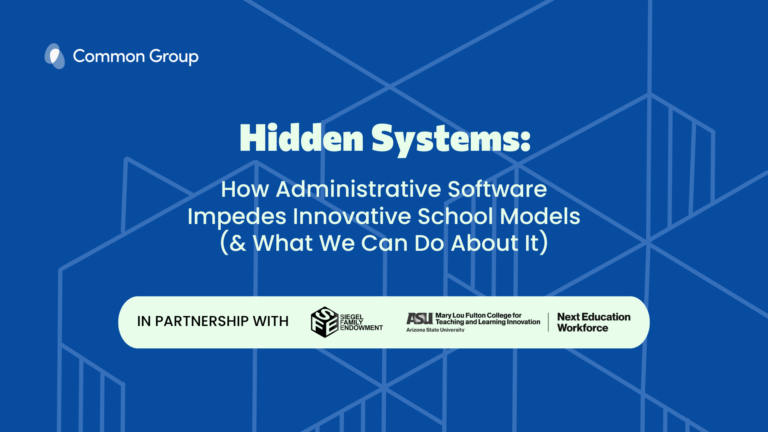
The New Growth Innovation Network (NGIN) is a knowledge, insight, and innovation hub, supporting economic development practitioners to advance inclusive economic growth in their regions. In its new report, NGIN argues that communities can leverage digital and social infrastructure in order to promote economic inclusion for economically disenfranchised people of color, women, and neglected geographies. The report identifies how digital inclusion can support wealth creation for these groups and the policies, investments, and pathways that can help activate this wealth creation.
We sat down with NGIN’s CEO and President M. Yasmina McCarty and Vice President of Insights and Innovations Swati Ghosh to discuss NGIN’s unique approach to economic development and to dive into some of the findings from their new report.
Traditionally, economic development hasn’t always focused on wealth creation for BIPOC and women. Why have you made prosperity for systematically excluded communities a centerpiece of your efforts at NGIN?
Yasmina: New Growth Innovation Network was set up by economic practitioners frustrated that the field and the practice of economic development was not delivering shared prosperity – especially for communities of color, especially for women, and especially for overlooked and neglected geographies. Our founding mission was that the model of economic development could and should be better. And the belief was to move beyond just a simple framework of job creation and income toward a framework of wealth creation and shared prosperity with an emphasis on those that face systemic barriers to economic advancement.
Given that focus on wealth creation for BIPOC, women, and other historically underserved communities, how does your approach to this work look different from traditional economic development programs?
Yasmina: It is an asset-led approach. There are many hidden assets, whether that be talent, business owners, or parts of your city and community. These hidden assets are not being leveraged to the fullest in your economic strategy. Therefore, your economy is not growing as strong as it could or should. An asset-led mindset says there are many more assets that could participate in our economy right now. How do we bring them into this and leverage the strengths, skills, and capabilities that they have to contribute to this part of our economy?
A second piece is the equity lens. NGIN’s approach centers equity—strategies, models and tools that support and advance inclusive economic growth—in all of our work. It is not an afterthought that’s layered on top of traditional economic development, but the key theme that we come back to again and again to ensure that historically disenfranchised communities benefit as much, if not more, from economic growth.
At the same time, you’re not arguing that existing community assets are sufficient for securing prosperity for all. What other resources and investments are necessary, and what does this look like in an asset-led approach?
Yasmina: There are assets in the community, but that doesn’t mean that you don’t have to invest in order to activate those assets into the kind of economic opportunities that we’re describing. Without some type of intermediary coming in to get involved, there’s going to continue to be these silos between the way things have always been done, and the individuals and communities and organizations which could do things differently.
Swati: That silo piece that Yasmina mentioned, we look at that very actively. We use equity and inclusion as a lens to break those silos down, and work across multiple silos and multiple systems.
Practically, how do you apply an equity lens to break down silos in ways that advance the outcomes around wealth creation and prosperity that you’d like to see?
Yasmina: In economic development, we look at equity in the process, the strategies, and the metrics. On the process side, it’s around true, meaningful participation, and power from the community in building the economic strategy for the region. In the strategy, it means building economic strategies together with organizations that represent economically disenfranchised communities or communities themselves so that they’re at the table and they’re shaping what development should look like. Then, finally, in metrics, the equity indicators should just be part of the overall project indicators, rather than separate.
Swati: The philosophy of trickle-down or the philosophy around [the idea] that when the tide rises, that raises all boats at the same time, that has not been shown to work. And so if you do not have policies, programs, interventions that are specifically helping these historically disenfranchised communities, then we’re going to have more of the same. The disparities are going to continue.
In your new report, you apply that equity lens to consider how digital and social infrastructure can be leveraged for wealth creation among communities that have been marginalized from economic prosperity. Why did you concentrate on the digital and social pieces, in particular? And what is the relationship between those elements and wealth creation?
Yasmina: We observed coming out of the pandemic that much of the conversation on digital inclusion was focused on education and learning. There was so little about digital inclusion’s effects on economic opportunity or wealth creation. That was the nugget that we were really curious about—why weren’t we hearing and reading and seeing more of that?
Swati: Our core question then became: how do we utilize digital infrastructure or digital equity for wealth creation for BIPOC and for women and for underinvested geographies? We found that question is not something that a lot of organizations or leaders are asking, connecting those dots. What happens once we get to the point of, yes, people have devices, people have access to Internet connections, people have the skills to utilize those devices and connections to do what they want? Does that translate to, or does it not translate to, wealth creation? And we found that the answer is “not automatically.” Digital equity has to be explicitly linked to wealth creation opportunities.
In your report, you identify three strategies for wealth creation: education, employment/entrepreneurship, and property ownership. Yet, you also point out that accessing the full potential of these pathways is challenging for members of the BIPOC community and others. Why is that?
Yasmina: The racial wealth gap that we have today, especially as it relates to Black/White, and White/Latino, is heavily due to policies laid out by our country as well as practical programs such as limiting access to finance, occupational segregation, taking land, etc. So there’s a long history of both policies and programs that delivered us this stark racial wealth gap.
Then the question is, ‘What can be done?’ The three areas that were laid out in the report are three areas that we already know can create wealth. But we should also be clear that overcoming the racial wealth gap is not just about owning a home or starting a business, because there continue to be barriers in place. For example, we consistently see discriminatory practices when it comes to access to capital—even though red-lining is illegal now.
What approaches to program design and resource allocation can address these challenges when it comes to wealth creation for the BIPOC community, women, and those from neglected geographies?
Swati: If we take digital pathways for education or entrepreneurship, it’s not just the provision of that digital infrastructure, but also wraparound support so that you are taking care of barriers for a whole person and not just part of a person. For example, if you’ve provided support to get Internet connection to the home [of a housing insecure person], and then that person ends up moving four months down the line, the infrastructure doesn’t move with the person. Strategies need to address those nuances of understanding the population better.
Yasmina: The things we get excited about look at the barrier which might keep Black or Latino families out of home ownership, such as the down payment, and try to do things like shared risk return on that investment. So, for example, if you wanted to purchase a home, but you didn’t have the full down payment, you would get an amount, but now that behaves like equity, rather than debt. And so, then when you do transact, and sell, there’s that shared risk, and return from the person who contributed to that. Those are really interesting interventions, because they look at a very narrow component.
What role can communities themselves play in helping to craft those policies?
Yasmina: As big a role as possible! For digital, the more that local content creators create solution sets and content for the communities that are being served the better. Those people can be individuals who’ve been digitally excluded for income or for racial background or location. In other areas, like small business, the solutions that are really winning now have been shaped by the small business owners or entrepreneurs themselves. Where they’re identifying, here are the challenges, whether they be capital, capacity, or operational support, and then lifting those solutions back up to both non-profits, as well as capital providers.
I’m not going to have the best answer for a community that I’m not sitting in or am grappling with the issues. The same goes for most of us.
Swati: There is this framework that NGIN often uses, which is Commitment, Capacity, and Capital. The role that community plays is in driving that commitment to a large extent, and holding leadership accountable to that commitment that a community ends up making, and ensuring that that commitment translates into capacity-building. That it’s not just at the surface level, but that it actually translates to capacity, because that is where the vast majority of work would happen. We find that with capacity and commitment, capital has an easier pathway to get to a community than in reverse.
In your report you describe some programs that have adopted community-driven models for digital equity, social infrastructure, and wealth creation. Could you tell us about some of those approaches?
Swati: The examples that we studied for this report, many of them are starting to do a better job of not just creating space at the table for the community to be a part of, but to actually do community empowerment. A great example is the Detroit Community Technology Project which is not just including those residents as a way to understand where the gaps are, but is actually training them with digital language fluency, as well as the build-out and maintenance of the infrastructure. And so you’ve now also created jobs. You’ve created a mechanism for maintenance, for that continued engagement of the community in that asset living on and improving on it.
Another example is the Digital Navigators program that we highlighted in Charlotte, North Carolina. That’s another program that utilizes community residents and workers to deliver the program and the services. In the Charlotte example, they’re co-creating that approach, and then utilizing the same residents to then deliver it.
I will say that in a lot of cases, they seem to be still at the early stage of connecting digital equity to wealth creation opportunities. We’re not sure how sustained this effort is over time. Detroit seems to be among the first to have done it. But outcomes are still difficult to study.
By definition, these efforts need to be localized and community-driven. But your report also looks at ways of scaling and learning across initiatives. Could you walk us through elements that you’ve seen lead to success in these wealth creation efforts, and some of the recommendations that you have?
Swati: [The Digital Navigators approach] is going viral. A number of communities are trying to adopt it and do it in different ways. Some are embedding it into a library system. Some are embedding it into the 311. They are definitely gaining traction. The Detroit example was the inspiration for how Tulsa is thinking about digital equity and taking it forward through a wealth creation framework. Drops combine together to make an ocean.
For more information on NGIN and to read their latest report, visit NGIN’s website.
Yasmina McCarty is CEO and President of NGIN, focused on inclusive economic growth and closing structural opportunity gaps, to ensure that people of color, women and overlooked geographies are a core part of regional economic growth and prosperity.
Swati Ghosh is Vice President, Insights and Innovations at NGIN. In this capacity, she leads NGIN’s program delivery to deliver insights, best practices and innovations which will advance the field of inclusive economic development.





